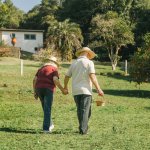Are You Ready to Connect? How Retirement Communities Foster Friendships and Enrich Lives
As we step into the golden years of life, the essence of connectivity and community becomes more vital than ever. Retirement communities across the country are not just facilities; they are vibrant hubs where older adults find new opportunities to forge friendships and enhance their social lives. In these close-knit settings, residents discover that the joy of connection is just a stone’s throw away. This article discusses how retirement communities are uniquely designed to foster these important connections, enhancing the lives of their residents through social engagement, shared interests, and supportive environments.
Cultivating a Sense of Community
Retirement communities are built around the concept of community living, which naturally encourages social interaction. From shared dining halls to group activities, these environments are meticulously designed to ensure that residents feel part of a cohesive group.
Regularly scheduled social events such as game nights, cultural dances, and communal gardening not only keep the calendar full but also provide residents with constant opportunities to engage with one another. This communal living arrangement helps mitigate feelings of loneliness and isolation, replacing them with a supportive network of their peers who share similar life experiences and interests.
Tailored Activities and Clubs
One significant advantage of retirement communities is their ability to improve quality of life through a broad range of activities tailored to the diverse interests of their residents. Whether it's a book club, a yoga class, or an art workshop, these activities are more than just pastimes; they are gateways to building lasting relationships.
Engaging in these activities allows residents to connect with people who have similar passions, fostering a deeper sense of connection, belonging, and camaraderie. This shared engagement not only enhances their daily lives but also promotes mental and physical well-being by keeping residents active and socially connected.
Support Systems and Health Wellness Programs
Retirement communities often emphasize holistic wellness, recognizing that physical health is deeply intertwined with social health. Many offer fitness programs, wellness workshops, and health seminars that encourage residents to take an active role in maintaining their health.
Participating in these programs together not only fosters a culture of health awareness but also builds strong support networks among residents. As they motivate each other to stay healthy, they form bonds that go beyond mere acquaintance, becoming companions in the journey of aging well. These support systems are vital, providing both emotional and practical support, which enhances the overall resilience of the community.
Strategic Locations Enhance Connectivity
Retirement communities often boast strategic locations that further enrich the lives of their residents. Many are situated in serene environments close to nature yet remain accessible to urban amenities, allowing easy visits from family and access to cultural events. Such thoughtfully chosen locations cater to a wide array of interests and needs, promoting a lifestyle that balances tranquility and vibrancy.
A noteworthy mention is the burgeoning scene of retirement communities in Texas, where the warm climate and rich cultural tapestry offer an appealing backdrop for senior living. These communities are typically located in picturesque settings that encourage outdoor activities all year round, from walking trails to community gardening.
The accessibility to major medical centers, shopping districts, and entertainment options ensures that the residents have everything they need within reach, fostering a sense of independence and engagement with the broader community. This strategic choice of location does not just affect the physical well-being of residents but profoundly influences their social lives, providing numerous opportunities to meet new people and try new things.
Technology Integration for Enhanced Communication
Retirement communities are increasingly integrating technology to keep residents connected not only with each other but also with the world around them. From Wi-Fi-enabled common areas to classes on using smartphones and social media, these communities are helping older adults stay in touch with their far away family and friends remotely.
The adoption of technology also includes the use of platforms for virtual gatherings, allowing residents to join in activities and celebrations that they cannot attend in person. This embrace of technology ensures that residents can maintain important relationships and continue to feel part of their extended communities and families, no matter the distance.
Continuous Learning and Intellectual Engagement
Many retirement communities recognize that learning and intellectual engagement can significantly enrich the social lives of their residents. They offer educational programs that range from guest lectures and language classes to music instruction and book discussions.
These programs not only stimulate the mind but also provide common ground for residents to connect intellectually and culturally. Engaging in learning opportunities helps older adults gain new skills and knowledge, fostering a sense of accomplishment and self-esteem, which are vital for maintaining social connections and personal well-being.
More to Read:
Previous Posts:
Next Posts:




